|
|
|
|
Katsushika Hokusai (1760 - 1849) is perhaps the most famous Japanese artist ever. There is so much information about him on the web that I won't go into detail here, but encourage you to do a web search if you want to know more about him. He was a bit eccentric, having changed his name and residence constantly through out his life. We see him as a great Japanese artist, but the style of some of his art is not very Japanese at all. As time went on Hokusai refused to conform to Japanese artistic conventions of the time -- to the chagrin of his peers -- but set out to try new styles, even incorporating western techniques. After his death he was far more popular in Europe than in Japan. He lived for his art, and described himself as an old man crazy about pictures. When his house burned down in his later years and money was scarce, he ran out of the house carrying only his brushes so he could continue drawing and painting. He lived to be eighty nine which was very unusual for Japanese at the time, and planned to live at least until one hundred and ten. On his deathbed, he lamented not having ten or even five more years to continue his art. As a Hokusai fan I am fortunate to live in Tokyo where I can to see many original works of Hokusai, trace his steps, visit sites he sketched, walk the streets of his childhood, and visit his burial place. Here are a few landmarks in Tokyo associated with Hokusai. The hot spot for Hokusai landmarks in Tokyo is the Ryogoku area in Sumida Ward in central Tokyo, also famous for its Sumo stadium and numerous sumo stables throughout the neighborhood. The birthplace of Hokusai: Hokusai Dori I had read that Hokusai was born in a place called Honjo Warigesui and that it was supposed to be in Katsushika. I had assumed that this was a reference to Katsushika ward which is several kilometers away from central Tokyo, to the north east. But when I visited the Edo-Tokyo Museum which is next to the Sumo stadium in Ryogoku, a Hokusai display indicated that Hokusai's birthplace was actually the area around the museum. I walked out of the museum exit on the east side and found myself on Hokusai Dori (Hokusai Avenue) which ran through the neighborhood where he was born. This is not far from my own neighborhood. The area is very near the Sumida River and was once named Honjo (part of it is still named Honjo). I assume it was once called Katsushika as well. There was a canal running through Honjo called Warigesui which was later filled in to make Hokusai Dori. I walked down the street and discovered reproductions of his works posted on lamp posts every few feet, two works per lamp post, on both sides of the street. There were dozens of such lamp posts and I made sure to stop at each one. We've all seen most of these works reproduced with much higher quality in art books, but the idea of strolling through Hokusai's old neighborhood, viewing his art on the street named after him was enough to make this a wonderful experience. Hokusai Dori begins at the museum and runs for several blocks until it crosses a bridge and goes by another name. 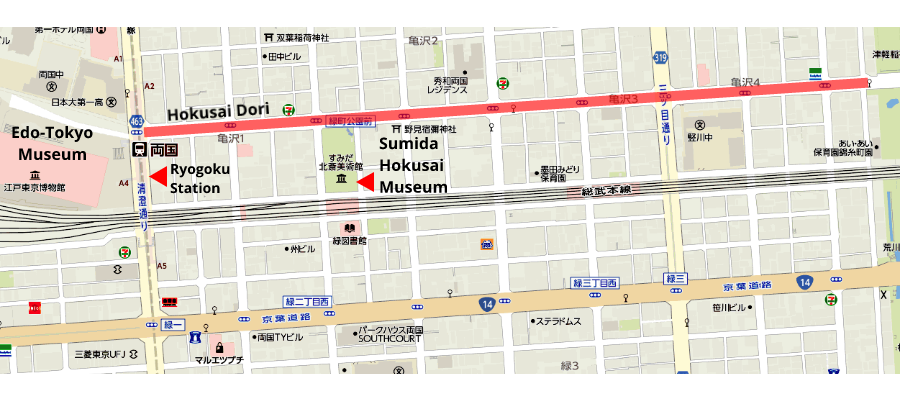 Note: many years after I wrote this description I discovered that the designation of Hokusai Dori was extended, and now I believe the entire street is officially called Hokusai Dori. So now it extends to the east (to the right) far past where the red line ends in my map. The closest station to Hokusai Dori is Ryogoku Station on the Oedo Line. The JR line also has a Ryogoku Station which is just to the west of this map and within walking distance.
At the end of his life Hokusai was living in a humble broken down shack in the same neighborhood where he was born To the right is a picture of him and his daughter OE (also an amazing artist) which was drawn by one of his disciples, Tsuyuki Kosho (a.k.a. Tsuyuki Iitsu II) five years before Hokusai's death. We see him covered with a FUTON (Japanese thick blanket), hunched over a sheet of paper on the floor with a brush in his hand. It was said that he would stay under that lice-ridden blanket for weeks during the winter, drawing, sleeping and then drawing again, and wouldn't come out from under it even when he had distinguished visitors. Hokusai was so driven to draw that he could endure cold, poverty and great discomfort. He didn't need a fancy sketchbook or other art supplies to keep him motivated. On his deathbed at the age of 88 or 89, he pleaded with heaven to grant him ten more years -- or even just five -- so that he could continue to draw and improve his art. He truly was "an old man mad crazy about pictures." At the Edo-Tokyo Museum you can see a miniature diorama which is based on the drawing. 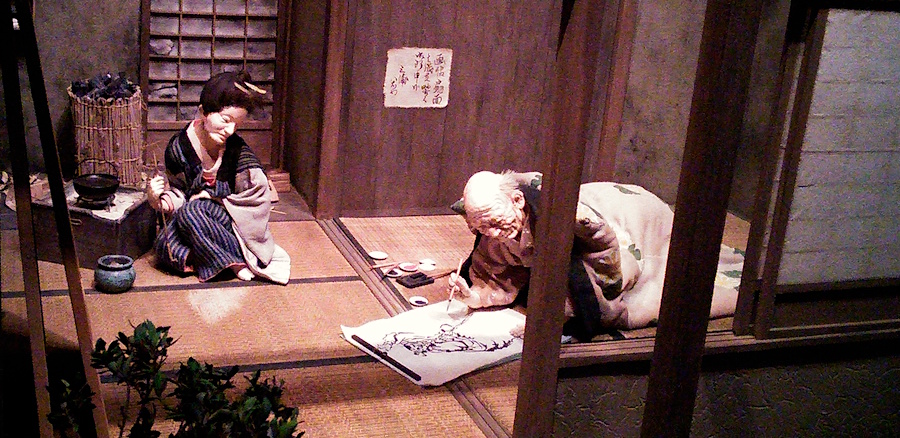 And at the Sumida Hokusai Museum which opened in November of 2016 you can see an amazing life-size display of this same scene; the figures will subtly move if you watch long enough (they won't move on this web page no matter how long you watch). 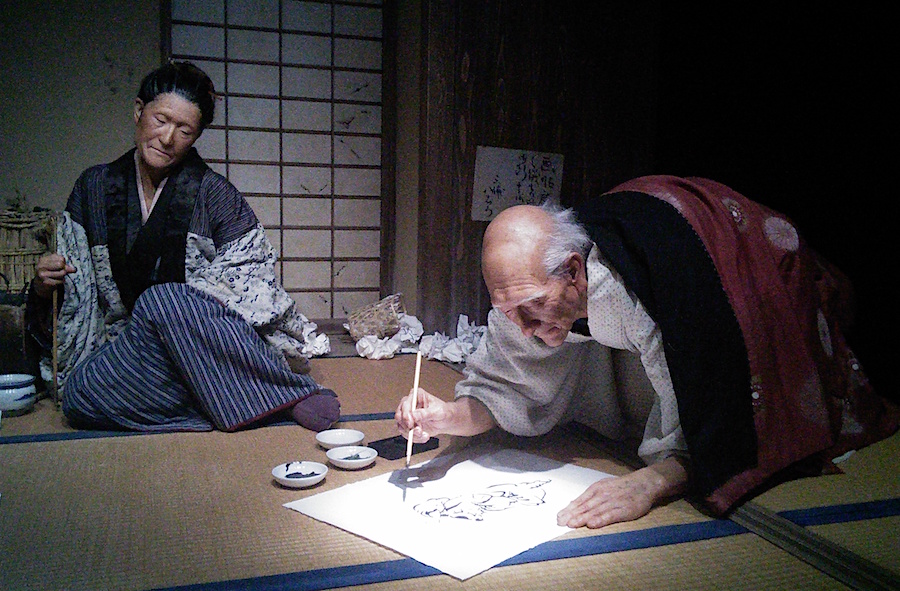 I visited the Sumida Hokusai Museum two days after it opened, which also happened to be the first day it snowed in Tokyo in the winter of 2016. It had a nice collection of woodblock prints and also actual paintings done by Hokusai, which I find much more fascinating than the woodblock prints. I saw at least two paintings which I had previously seen at the Hokusai museum (Hokusai Kan) in Obuse, Nagano prefecture, so apparently there is an arrangement between the two museums. Most of the displays in the permanent exhibition have titles in Japanese and English, but the descriptions are in Japanese only. At the special exhibition there were practically no titles or descriptions in English; just Japanese. Hopefully there will be more descriptions in foreign languages as the number of foreign visitors increases. 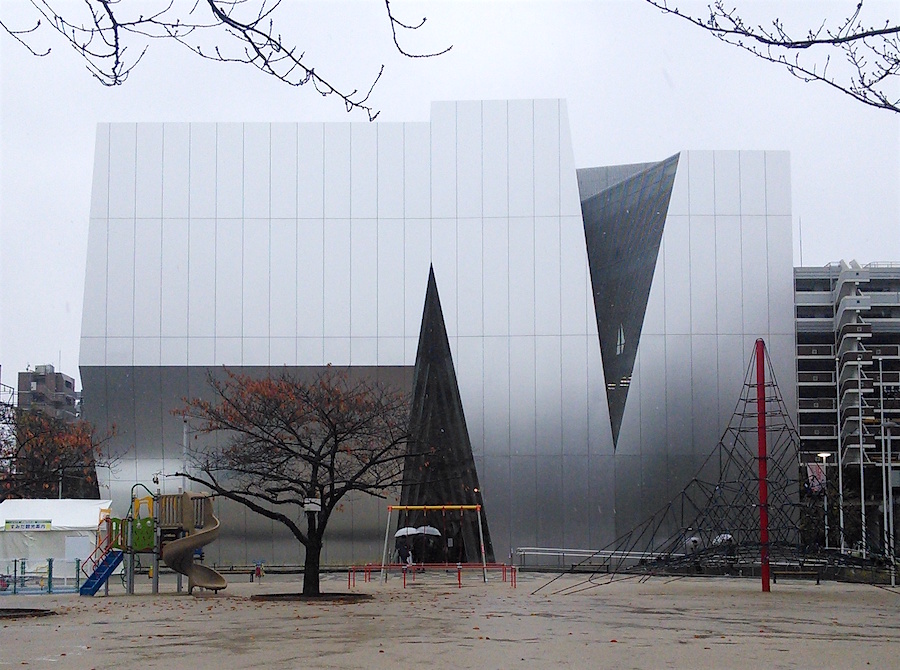 Other than the language barrier, my only complaint about the Sumida Hokusai Museum is the tiny restrooms which accommodate only one person at a time. So there will often be a line of anxious people waiting to use them. They are so small that you may have trouble squeezing past the sink once you have opened the door, and it's even more difficult to get back out because the door opens inward. The architect who designed such an impressive artsy building neglected something as crucial as sufficient restrooms for the crowds. I suspect this will be the museum's first major renovation in the future. Anyway, I suggest that before you enter the museum, you visit the public restrooms in the park in front of the museum. Speaking of restrooms... At the east end of Hokusai Dori there was a public restroom decorated with Hokusai art, but it was removed in 2014. (And Hokusai Dori has been extended, so this is no longer the east end.)
Inside was a wall display explaining that this was the neighborhood where Hokusai was born. I did not take photos inside the restroom although much of the interior -- including the toilets -- was visible from the street. That's one aspect of life in Tokyo that takes some getting used to, but it's gradually changing -- and maybe that's why they tore down that restroom (or maybe the local authorities finally realized that a toilet is not the most fitting tribute to a great historical figure). Where exactly was Hokusai born? I have a reproduction of an old map of Tokyo from the Edo era that includes the names of families who owned property, even small lots the size of houses. In the Honjo Warigesui area of the map I found property with the names Kawamura (Hokusai's family name which is also on his grave stone) and Nakajima (the name of the family that adopted him while he was a small child). It is probably a coincidence; the neighborhood of Hokusai's birth is known, but the exact location of the home is supposed to be a mystery. I proceeded to the spots indicated on my old map (which only gave a general indication since the roads have apparently changed since then). I hoped to find some evidence of the Kawamura and Nakajima families, maybe a house or business with those names. Unfortunately there was not a trace. Anyway, I did discover the general neighborhood of Hokusai's birth if not the exact spot. The grave of Hokusai The photo of the statue below is from the temple grounds where Hokusai is buried. Like many others who have seen this statue I was skeptical. It could have been a statue of any old man. But It does resemble the few drawings of Hokusai done by his students as well as his own self portraits. To the right of the statue photo is the grave of Hokusai in the middle of a small crowded cemetery. It is the family grave site which existed long before he became famous. The family name Kawamura is inscribed on the base of the stone inside the wooden structure. His final artist name was Gakyo Rojin Manji which can be translated old man mad crazy about pictures. The Buddhist symbol manji looks like a swastika and means 10,000 which implies perpetuity or long life.
This name is inscribed on the main stone. Inset in the middle of the photo is the inscription enlarged. I've given the inset more contrast and sharpness so you can read it, but it is inscribed in very stylistic cursive kanji, so I've provided the standard kanji to the right as well. The bars over some vowels tell you to hold the syllable a little longer than the others. This image of the kanji is an SVG (Scalable Vector Graphic) so you can pinch out to see it more clearly. 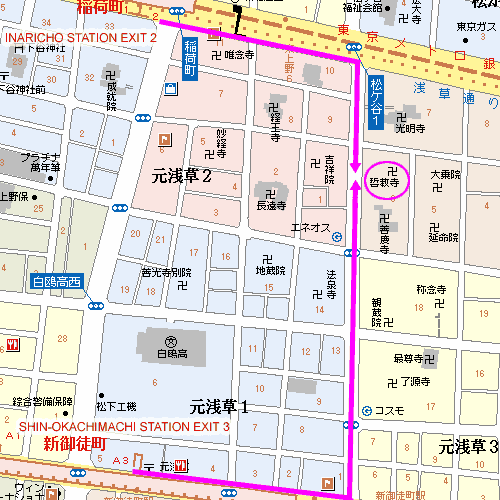 To visit the grave, take either the Oedo Line to Shin-Okachimachi Station, Exit A3, or the Ginza Line to Inaricho Station, exit 2 (exit 2 is only accessible from trains going in one direction; You may have to go out exit 3 and cross the street to find yourself at exit 2). Follow the arrows to Seikyo-ji Temple where Hokusai's grave is located. It's a very small temple and easy to miss, but there are signs in front marking it as Hokusai's grave site. After you enter the gates, the statue will be on your left. In front of you will be the main temple building. To the right will be another building which connects to the temple making an L shape. There is a small path to the right of that building. Take it and follow the winding passage until you find the grave (you can't miss it). You will feel like you are trespassing, but it's the only way for visitors to enter the cemetery, and visitors are welcome. I have visited this site many times. For no particular reason I have cut up and re-assembled one of Hokusai's most famous works, turning it into 3D art. I have uploaded it here for the fun of it. | ||||||||
|
| Finally a complete set of faithful reproductions of Hokusai Manga in one volume! For those who are not familiar, Hokusai Manga was a set of 15 books of woodblock prints of drawings and sketches by Katsushika Hokusai. The original Hokusai Manga volumes were first published one volume at a time between 1814 and 1878 (Hokusai died in 1849, having finished the art, but before the final volumes were published). This was back when the word "manga" meant art that had a light feeling, and most likely the term was coined with the creation of this work. Many of the sketches will make you chuckle.
Being basically a book of pictures, there is very little text, but there is an English introduction page in the beginning (like many Japanese books, the beginning is on the right side). No serious Hokusai fan should be without this huge book (it's hardbound, about 6 centimeters thick, and comes in its own case). No other published set of reproductions even comes close. You will be amazed by the lively brush strokes which were faithfully reproduced by the top wood block carvers of the day. My own copy has brought hours of study, and will be well used for years to come. Final word Here is Hokusai's most famous quote which he must have said in his mid seventies. This English translation was supplied by AI. From the age of six I had a mania for drawing the forms of things. Katsushika Hokusai had high hopes for living a long life and continuing his progress in art. He did not live till one hundred and ten but died at the age eighty-nine or ninety so his life was still much longer than most Japanese at the time. |
|||||||
 |